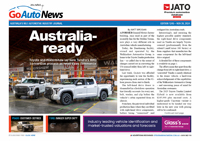Make / Model Search
News - Market Insight - Market Insight 2021Cars become SUVs to blur the linesAmbiguous: The Skoda Kamiq is classified as an SUV but it closely resembles a hatch or station wagon and is not available with all-wheel drive. Passenger cars hit record lows as market booms and SUVs, LCVs take the creamGallery Click to see larger images 13 Dec 2021 By NEIL DOWLING THE passenger car segment has had its worst year on record, sales plunging by half in a mere six years as a swell of SUVs are parked on Australian driveways.
Even light-commercial vehicles (LCVs) have taken away the passenger car’s once-dominant position, up 22 per cent on 2016’s annual figures.
Despite the launch of about a dozen new passenger cars this year, the overwhelming majority of new-vehicle buyers want SUVs or utes. The same weight is seen in the used-car sector.
While it is a well-known fact that SUVs continue to outsell traditional passenger cars, the main reason is attributed to the presumption of added versatility and increased cabin space offered by an SUV.
But maybe that – and fashion – are not the main reasons. Maybe cars are not as much on the nose as we first thought.
Much of the decline in passenger car interest stems in the definition.
Increasingly, new models are being marketed as SUVs when they are virtually indistinguishable from a hatchback or wagon.
They generally have two-wheel drive – certainly that’s the case with most of those in the light SUV segment and many in the busier small SUV sector – to further align them with cars.
Examples are many but include the Suzuki Ignis and Kia Niro that resemble hatchbacks from the passenger-car sector but are listed as SUVs.
Consider that if the light SUV sector was included in the passenger car category, it would move about 48,000 units (year-to-date November 2021) – equivalent to 19 per cent of the car sector – and greatly diminish the apparent decline in passenger car sales.
Passenger car entrants this year include the Hyundai Sonata, Skoda Scala, BMW 3 and 4 Series, Honda Civic hatch, Hyundai Nexo and Toyota Mirai hydrogen cars, Volkswagen Arteon and Golf, Genesis G80, updates to the Jaguar XE and XF, and the Mercedes-Benz S-Class.
Together with ongoing models, there are 105 models in the passenger car bubble compared with 128 SUV models.
The biggest sellers in the passenger car range this year to date are led by the Toyota Corolla (27,497 units fo the 11 months of 2021), Hyundai i30 (23,334), Kia Cerato (17,198), Mazda3 (13,476), MG3 (12,911), Toyota Camry (12,133) and from the Micro class, the Kia Picanto with 6110 sales.
New SUV category entrants include the Skoda Kamiq, Isuzu MU-X, Hyundai Palisade and Tucson, Kia Sportage and Sorento plug-in hybrid, Mitsubishi Outlander, Toyota LandCruiser 300 and Kluger, Mercedes EQA and Genesis GV70.
Biggest sellers are the Toyota RAV4 (32,753 units to the end of November), Mazda CX-5 (22,820), Toyota Prado (19,095), MG ZS (16,443), Toyota LandCruiser 200/300 (13,535), Mitsubishi ASX (13,712), Mazda CX-30 (12,356) and Hyundai Kona with 12,170 sales.
Light-commercial vehicles (LCVs) have overtaken sales of passenger cars for the first time.
The favourites are also the nation’s top-selling cars led by the 4x4 models of the Ford Ranger (42,239 sales to date), Toyota Hilux (36,987), Isuzu Ute D-Max (17,164), Mitsubishi Triton (14,902) and Mazda BT-50 (11,790).  |
Click to shareMarket Insight articlesResearch Market Insight Motor industry news |










Facebook Twitter Instagram